SoapUI Tutorial
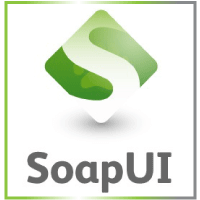
SoapUI is the world’s leading open-source testing platform. It is the most widely used automation tool for testing web services and web APIs of SOAP and REST interfaces. It is a boon for testers to test functional and non-functional testing, such as automated testing, functional, load testing, regression, simulation and mocking without hindrance because its user interface is very simple to use. It supports various standard protocols such as HTTP, HTTPS, REST, AMF, JDBC, SOAP, etc., that exchange information in structured data such as XML, plain text or JSON, etc. with the help of network services or web APIs in a computer.
Why we use SoapUI?
It is an important tool to test the Web domain, and it is an open-source, cross-platform as well as language independent that supports Eclipse, NetBeans, and IDEA. It allows the testers to test functional, non-functional testing, performance testing, regression testing, compilation, and load testing on various Web services and APIs.
SoapUI Architecture
Following is the general architecture of the SoapUI.
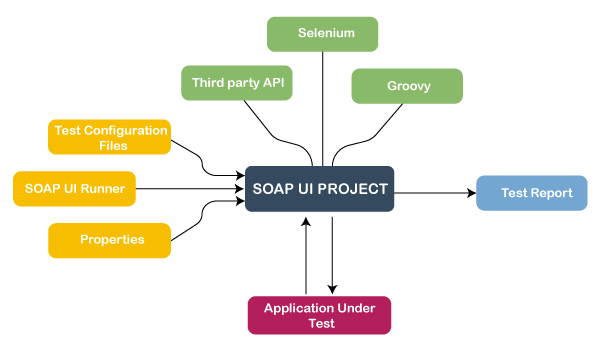
Test config files: The test config files are the configuration files that include test data, database connection, variables, expected results and any other environmental setup or test specific details.
Selenium: It is a Selenium JAR that uses UI automation.
Groovy: Groovy is a library that enables SoapUI to provide groovy as a scripting language to its users.
Third-party API: It is a third-party API that is used to create customized test automation frameworks.
Properties: These are the test requested properties files that are used to hold any dynamically generated data. The test property is also used in the configuration of SSL and other security configurations for test requests.
SoapUI Runner: It is used to run the SoapUI project.
Test Report: A SoapUI generates a Junit test style report and user reporting utility to report test results.
SoapUI Released
A SoapUI is a cross-platform and language-independent which was first released by Eviware in September 2005 at SourceForge, later acquired by SmartBear in 2011. And when its first version release, it has been downloaded by 2000,000 times. The SoapUI software is a licensed software under the terms of a European Union public license. It is purely based on the Java platform that uses Swing for the User Interface, and it can run on most of the latest operating systems, including MAC, Linux and Windows. Furthermore, its cross-pltform behavior it supports Eclipse, IDEA and NetBeans.
Some Protocols and Technologies
The following are the essential protocols and technologies used in the SoapUI.
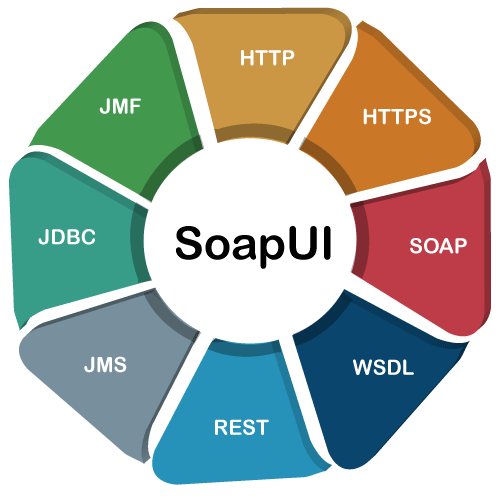
SOAP stands for Simple Object Access Protocol
REST stands for Representational State Transfer
WSDL stands for Web Services Definition Language
HTTP stands for Hyper Text Transmission Protocol
HTTPS stands for Hyper Text Transmission Protocol Secured
AMF stands for Action Message Format
JMS stands for Java Messaging Services
JDBC stands for Java Database Connectivity
Advantages of SoapUI
- It provides a simple and user-friendly Graphical User Interface (GUI).
- Cross-platform desktop-based application.
- It supports all standard protocols and technologies such as HTTP, HTTPS, AMF, JDBC, SOAP, WSDL, etc.
- SoapUI costs less than all other test tools available in the market.
- It is also used as message broadcasting.
- It provides a fast and well-organized framework that generates lots of web services tests.
- It creates mocks where testers can test real applications.
- It supports drag and drops features to access script development.
- Transferring data from one response or source to different API calls without manual interaction in the SoapUI tool.
- It facilitates tester and developer teams to work together.
- SOAPUI tool provides the facility to get data from various sources of web service without developing any code.
Disadvantages of SoapUI
- Security testing requires enhancements.
- The Mock response module should be more enhances and simplified.
- It takes longer to request big data and dual tasks to test web services.
SoapUI Testing
The following are the different types of testing in SoapUI tools.
1. Functional Testing
It is the powerful and innovative features that validate the functional or behavioral tests of web services and applications. Let’s discuss the features of the SoapUI supports as follows:
- It provides the user-defined scripts that can be customized as per the requirement of the testing.
- Drag-Drop: It supports drag and drops features to create and run the most complex test scenarios.
- Multi Environment Support: It supports multi-environment to switch between various environments like QA, Dev, and prod environment.
- Test Coverage: SoapUI allows testers to dynamically analyze how a SOAP or REST service is covered by functional testing.
- Data Driven Testing: SoapUI allows the tester to debug and develop data-driven tests.
Load Testing
Load testing is used to analyze the web service or web API’s behavior based on specific tasks or load. Generally, a Load test is used in SOAPUI to test performance assessments of web services such as load, stress, and endurance of all non-functional testing types. Let’s discuss the features of the SoapUI supports as follows:
- Ease of Use: Using a simple user interface and handling the LoadUI agents of SoapUI tools makes load testing very easy and simple.
- LoadUI Agents: SoapUI contains the number of LoadUI agents to analyze distribution and performance on various parameters.
- Performance Monitoring: A SoapUI has an efficient and advanced reporting system for collecting test results on various performance parameters for load testing.
Security Testing
Security testing is an important tool that is used to ensure the authentication and authorization of Web Services and Web API by using the request and response model in the SoapUI. Let’s discuss the features of the SoapUI supports as follows:
- Cross-Site Scripting: A cross-site scripting is a security test that scans and detects potential risks on specific parameters in structured messages.
- Security Database: As the name suggests, the security database that detects and scans some potential SQL injections may damage the database.
- Stack Overflow: It is used in the SoapUI web testing tool to scan and locate massive documents within XML messages that can cause a stack overflow.
Compliance Testing
A compliance testing consists of a source and data authentication license certificate and various service agreements to validate a web service or web API. Furthermore, these data authentication certificates and test scripts call before and after compliance testing of a SoapUI tool to check if the last received message is associated with the WSDL or WADL schema definition.
Regression Testing
Regression testing is functional testing used in the SoapUI tool to analyze the bugs or malfunctions of the web service. And it also reverifies the web service after new changes in the current release tools. In other words, we can say that it is the responsibility of a tester to execute the test suits and certify whether the existing functionalities are not breaking after the new changes to the SoapUI tools and its working fine with the tools.
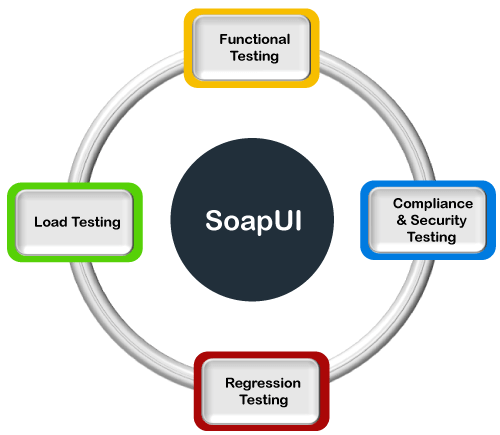
Features of SoapUI
The following are the essential features of SoapUI tool.
- It provides a simple and easy user interface for Technical and Non -Technical person.
- It supports all standard protocols and technologies to test different APIs and web services.
- It provides security or vulnerability testing of the system against malicious SQL commands, boundary limitation scanning, or stack overflows.
- It allows own building plugin for the different open-source environment.
SoapUI Integration:
SoapUI tools are integrated with popular building tools.
Apache Ant: It is used to build projects and run test suites using the command line in SoapUI Tools.
Hudson: It is a Java-based tool, integrated with the SoapUI tool to quickly find bugs on every commit at the code’s click from the development team.
Maven: It is a project management automation tool for creating only a java-based project.
JUnit: It is a Java-Based unit testing framework that is integrated with the SoapUI tool to perform unit testing for web services and web APIs.
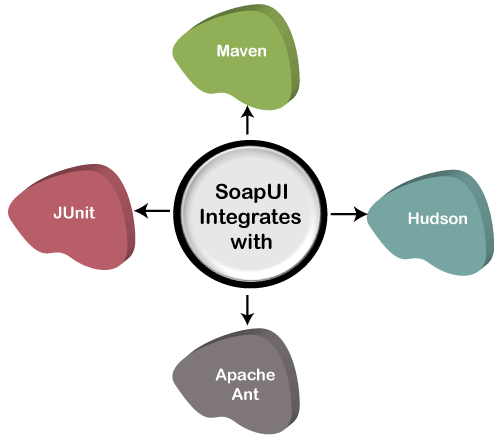
SoapUI Version
The following are the different versions of SoapUI since its initial release.
| Version Name | Release Notes | Release Date |
|---|---|---|
| SoapUI 1.0 | The Initial Release | 2005/10/16 |
| SoapUI 1.5 | The LoadTesting Release | 2006/04/06 |
| SoapUI 1.6 | The Tools Release | 2006/11/12 |
| SoapUI 1.7 | The Mock/ Pro Release | 2007/04/10 |
| SoapUI 2.0 | The Coverage Release | 2007/12/12 |
| SoapUI 2.5 | The REST Release | 2008/11/18 |
| SoapUI 3.0 | The Reporting Release | 2009/07/09 |
| SoapUI 3.5 | The Protocol Release | 2010/03/01 |
| SoapUI 3.6 | The loadUI Release | 2010/09/14 |
| SoapUI 4.0 | The Security Release | 2011/06/14 |
| SoapUI 4.5 | The Big Ears Release | 2012/03/28 |
| SoapUI 5.2 | Major New Features Release | 2015/07/02 |
| SoapUI 5.3 | SoapUI Open Source | 2016/12/05 |
| SoapUI 5.4 | Open Source | 2017/11/27 |
| SoapUI 5.5 | Open Source | 2019/02/12 |
Prerequisite
Before learning the SoapUI, you must have the basic knowledge of client/server environment and the SOAP, WSDL, REST, and the XML.
Audience
Our SoapUI tutorial is designed in a way that helps both beginners and professionals.
Problems
We assure you that you will not face any problems in the SoapUI tutorial. But if there is any mistake, please post the problem in the contact form.
